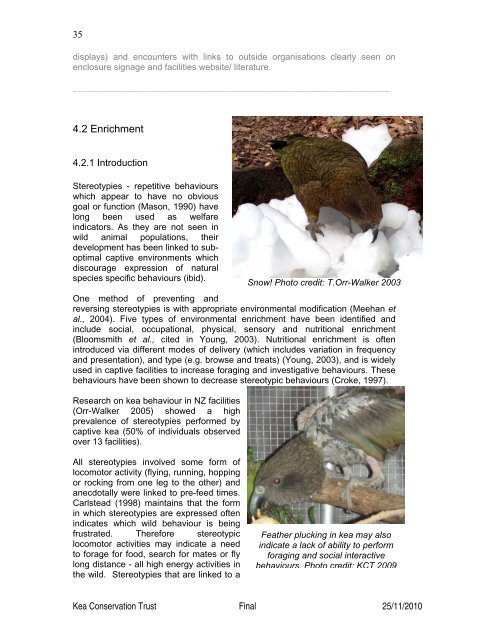(Nestor notabilis) Husbandry Manual - Kea Conservation Trust
(Nestor notabilis) Husbandry Manual - Kea Conservation Trust
(Nestor notabilis) Husbandry Manual - Kea Conservation Trust
Create successful ePaper yourself
Turn your PDF publications into a flip-book with our unique Google optimized e-Paper software.
35<br />
displays) and encounters with links to outside organisations clearly seen on<br />
enclosure signage and facilities website/ literature.<br />
________________________________________________________________<br />
4.2 Enrichment<br />
4.2.1 Introduction<br />
Stereotypies - repetitive behaviours<br />
which appear to have no obvious<br />
goal or function (Mason, 1990) have<br />
long been used as welfare<br />
indicators. As they are not seen in<br />
wild animal populations, their<br />
development has been linked to suboptimal<br />
captive environments which<br />
discourage expression of natural<br />
species specific behaviours (ibid).<br />
One method of preventing and<br />
reversing stereotypies is with appropriate environmental modification (Meehan et<br />
al., 2004). Five types of environmental enrichment have been identified and<br />
include social, occupational, physical, sensory and nutritional enrichment<br />
(Bloomsmith et al., cited in Young, 2003). Nutritional enrichment is often<br />
introduced via different modes of delivery (which includes variation in frequency<br />
and presentation), and type (e.g. browse and treats) (Young, 2003), and is widely<br />
used in captive facilities to increase foraging and investigative behaviours. These<br />
behaviours have been shown to decrease stereotypic behaviours (Croke, 1997).<br />
Research on kea behaviour in NZ facilities<br />
(Orr-Walker 2005) showed a high<br />
prevalence of stereotypies performed by<br />
captive kea (50% of individuals observed<br />
over 13 facilities).<br />
All stereotypies involved some form of<br />
locomotor activity (flying, running, hopping<br />
or rocking from one leg to the other) and<br />
anecdotally were linked to pre-feed times.<br />
Carlstead (1998) maintains that the form<br />
in which stereotypies are expressed often<br />
indicates which wild behaviour is being<br />
frustrated. Therefore stereotypic<br />
locomotor activities may indicate a need<br />
to forage for food, search for mates or fly<br />
long distance - all high energy activities in<br />
the wild. Stereotypies that are linked to a<br />
Snow! Photo credit: T.Orr-Walker 2003<br />
Feather plucking in kea may also<br />
indicate a lack of ability to perform<br />
foraging and social interactive<br />
behaviours. Photo credit: KCT 2009<br />
<strong>Kea</strong> <strong>Conservation</strong> <strong>Trust</strong> Final 25/11/2010












